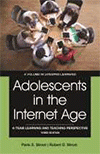
Adolescents in the Internet Age
A Team Learning and Teaching Perspective Third Edition
By:
Paris S. Strom, Auburn University
Robert D. Strom, Arizona State University
A volume in the series: Lifespan Learning. Editor(s): Paris S. Strom, Auburn University. Robert D. Strom, Arizona State University.
Published 2021
This book is intended for prospective secondary teachers, university education and human development faculty and students, and in-service secondary school teachers. The text focuses on the current environment of adolescents. Physical growth, sexuality, nutrition, exercise, and substance abuse receive attention. Social development depends on consideration of advice given by peers and adults. Neuroscience insights are reported on information processing, attention and distraction. Detection of cheating, cyber abuse, and parental concerns are considered. Career exploration issues are discussed. Visual intelligence, creative thinking, and Internet learning are presented with ways to help students gauge risks, manage stress, and acquire resilience.
Peers become the most prominent influence on social development during adolescence, and they recognize the Internet as their greatest resource for locating information. Teachers want to know how to unite these powerful sources of learning, peers and the Internet, to help adolescents acquire teamwork skills employers will expect of them. This goal is achieved by implementing Collaboration Integration Theory. Ten Cooperative Learning Exercises and Roles (CLEAR) at the end of chapters allow each student to choose one role per chapter. Insights gained from these roles are shared with teammates before work is submitted to the teacher. This approach enables students to select assignments, expands group learning, and makes everyone accountable for instruction. The adult teacher role becomes more creative as they design exercises and roles that differentiate team learning. Using Zoom or other platforms a teacher can observe or record cooperative team sharing. Involvement with CLEAR can enable prospective teachers to apply this system to empower their secondary students.
CONTENTS
Preface, Authors, and Acknowledgment. PART I: IDENTITY EXPECTATIONS Chapter 1: Adolescence: Theory and Research. Chapter 2: Cultural Change and Education. Chapter 3: Career Exploration and Adult Status. PART II: COGNITIVE EXPECTATIONS Chapter 4: Mental Abilities and Achievement. Chapter 5: The Internet and Media Literacy. Chapter 6: Creative Thinking and Problem Solving. PART III: SOCIAL EXPECTATIONS Chapter 7: Peer Socialization and Teamwork. Chapter 8: Risks for Adolescents and Schools. Chapter 9: Values, Ethics, and Integrity. PART IV: HEALTH EXPECTATIONS Chapter 10: Physical Health and Lifestyle. Chapter 11: Peer Abuse and Civil Behavior. Chapter 12: Student Stress and Resilience.
-
Paperback978-1-64802-381-1
Web price: $45.04 (Reg. 52.99)
-
Hardcover978-1-64802-382-8
Web price: $80.74 (Reg. 94.99)
- eBook978-1-64802-383-5

- EDU050000 - EDUCATION: Collaborative & Team Teaching
- EDU039000 - EDUCATION: Computers & Technology
- EDU040000 - EDUCATION: Philosophy & Social Aspects
-
 Adolescents In The Internet Age, 2nd Edition
Teaching And Learning From Them
Adolescents In The Internet Age, 2nd Edition
Teaching And Learning From Them
-
 Adult Learning and Relationships
Adult Learning and Relationships
-
 Learning Throughout Life
An Intergenerational Perspective
Learning Throughout Life
An Intergenerational Perspective
-
 Parenting Young Children
Exploring the Internet, Television, Play, and Reading
Parenting Young Children
Exploring the Internet, Television, Play, and Reading
-
 Polling Student Voices for School Improvement
A Guide for Educational Leaders - 2nd Edition
Polling Student Voices for School Improvement
A Guide for Educational Leaders - 2nd Edition
-
 Polling Students for School Improvement and Reform
Polling Students for School Improvement and Reform
-
 Thinking in Childhood and Adolescence
Thinking in Childhood and Adolescence

